Karim Benyekhlef
Robots in the Middle: Evaluating LLMs in Dispute Resolution
Oct 09, 2024



Abstract:Mediation is a dispute resolution method featuring a neutral third-party (mediator) who intervenes to help the individuals resolve their dispute. In this paper, we investigate to which extent large language models (LLMs) are able to act as mediators. We investigate whether LLMs are able to analyze dispute conversations, select suitable intervention types, and generate appropriate intervention messages. Using a novel, manually created dataset of 50 dispute scenarios, we conduct a blind evaluation comparing LLMs with human annotators across several key metrics. Overall, the LLMs showed strong performance, even outperforming our human annotators across dimensions. Specifically, in 62% of the cases, the LLMs chose intervention types that were rated as better than or equivalent to those chosen by humans. Moreover, in 84% of the cases, the intervention messages generated by the LLMs were rated as better than or equal to the intervention messages written by humans. LLMs likewise performed favourably on metrics such as impartiality, understanding and contextualization. Our results demonstrate the potential of integrating AI in online dispute resolution (ODR) platforms.
From Text to Structure: Using Large Language Models to Support the Development of Legal Expert Systems
Nov 01, 2023



Abstract:Encoding legislative text in a formal representation is an important prerequisite to different tasks in the field of AI & Law. For example, rule-based expert systems focused on legislation can support laypeople in understanding how legislation applies to them and provide them with helpful context and information. However, the process of analyzing legislation and other sources to encode it in the desired formal representation can be time-consuming and represents a bottleneck in the development of such systems. Here, we investigate to what degree large language models (LLMs), such as GPT-4, are able to automatically extract structured representations from legislation. We use LLMs to create pathways from legislation, according to the JusticeBot methodology for legal decision support systems, evaluate the pathways and compare them to manually created pathways. The results are promising, with 60% of generated pathways being rated as equivalent or better than manually created ones in a blind comparison. The approach suggests a promising path to leverage the capabilities of LLMs to ease the costly development of systems based on symbolic approaches that are transparent and explainable.
LLMediator: GPT-4 Assisted Online Dispute Resolution
Jul 27, 2023



Abstract:In this article, we introduce LLMediator, an experimental platform designed to enhance online dispute resolution (ODR) by utilizing capabilities of state-of-the-art large language models (LLMs) such as GPT-4. In the context of high-volume, low-intensity legal disputes, alternative dispute resolution methods such as negotiation and mediation offer accessible and cooperative solutions for laypeople. These approaches can be carried out online on ODR platforms. LLMediator aims to improve the efficacy of such processes by leveraging GPT-4 to reformulate user messages, draft mediator responses, and potentially autonomously engage in the discussions. We present and discuss several features of LLMediator and conduct initial qualitative evaluations, demonstrating the potential for LLMs to support ODR and facilitate amicable settlements. The initial proof of concept is promising and opens up avenues for further research in AI-assisted negotiation and mediation.
JusticeBot: A Methodology for Building Augmented Intelligence Tools for Laypeople to Increase Access to Justice
Jul 27, 2023



Abstract:Laypeople (i.e. individuals without legal training) may often have trouble resolving their legal problems. In this work, we present the JusticeBot methodology. This methodology can be used to build legal decision support tools, that support laypeople in exploring their legal rights in certain situations, using a hybrid case-based and rule-based reasoning approach. The system ask the user questions regarding their situation and provides them with legal information, references to previous similar cases and possible next steps. This information could potentially help the user resolve their issue, e.g. by settling their case or enforcing their rights in court. We present the methodology for building such tools, which consists of discovering typically applied legal rules from legislation and case law, and encoding previous cases to support the user. We also present an interface to build tools using this methodology and a case study of the first deployed JusticeBot version, focused on landlord-tenant disputes, which has been used by thousands of individuals.
Toward an Intelligent Tutoring System for Argument Mining in Legal Texts
Oct 24, 2022



Abstract:We propose an adaptive environment (CABINET) to support caselaw analysis (identifying key argument elements) based on a novel cognitive computing framework that carefully matches various machine learning (ML) capabilities to the proficiency of a user. CABINET supports law students in their learning as well as professionals in their work. The results of our experiments focused on the feasibility of the proposed framework are promising. We show that the system is capable of identifying a potential error in the analysis with very low false positives rate (2.0-3.5%), as well as of predicting the key argument element type (e.g., an issue or a holding) with a reasonably high F1-score (0.74).
Data-Centric Machine Learning in the Legal Domain
Jan 17, 2022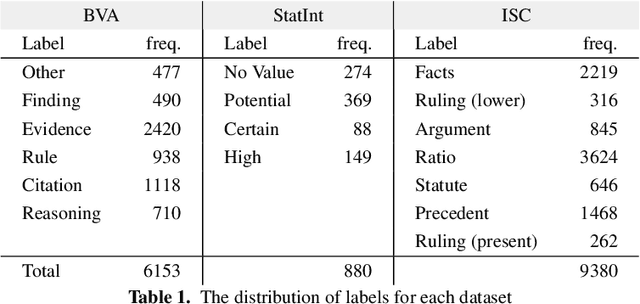



Abstract:Machine learning research typically starts with a fixed data set created early in the process. The focus of the experiments is finding a model and training procedure that result in the best possible performance in terms of some selected evaluation metric. This paper explores how changes in a data set influence the measured performance of a model. Using three publicly available data sets from the legal domain, we investigate how changes to their size, the train/test splits, and the human labelling accuracy impact the performance of a trained deep learning classifier. We assess the overall performance (weighted average) as well as the per-class performance. The observed effects are surprisingly pronounced, especially when the per-class performance is considered. We investigate how "semantic homogeneity" of a class, i.e., the proximity of sentences in a semantic embedding space, influences the difficulty of its classification. The presented results have far reaching implications for efforts related to data collection and curation in the field of AI & Law. The results also indicate that enhancements to a data set could be considered, alongside the advancement of the ML models, as an additional path for increasing classification performance on various tasks in AI & Law. Finally, we discuss the need for an established methodology to assess the potential effects of data set properties.
Sentence Embeddings and High-speed Similarity Search for Fast Computer Assisted Annotation of Legal Documents
Dec 21, 2021
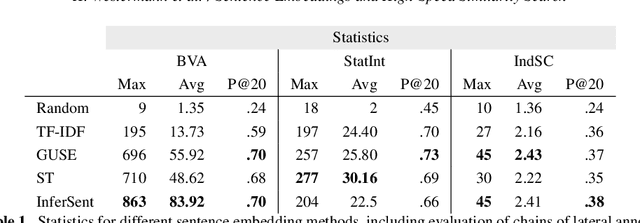
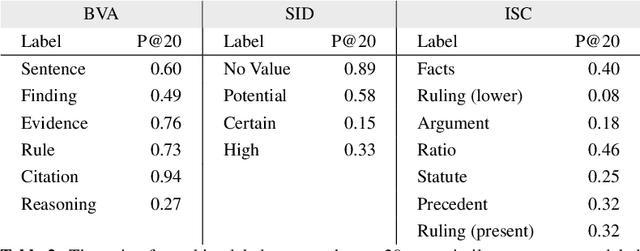

Abstract:Human-performed annotation of sentences in legal documents is an important prerequisite to many machine learning based systems supporting legal tasks. Typically, the annotation is done sequentially, sentence by sentence, which is often time consuming and, hence, expensive. In this paper, we introduce a proof-of-concept system for annotating sentences "laterally." The approach is based on the observation that sentences that are similar in meaning often have the same label in terms of a particular type system. We use this observation in allowing annotators to quickly view and annotate sentences that are semantically similar to a given sentence, across an entire corpus of documents. Here, we present the interface of the system and empirically evaluate the approach. The experiments show that lateral annotation has the potential to make the annotation process quicker and more consistent.
Lex Rosetta: Transfer of Predictive Models Across Languages, Jurisdictions, and Legal Domains
Dec 15, 2021
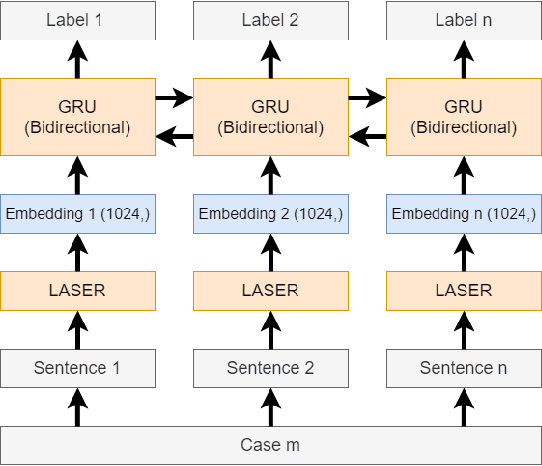

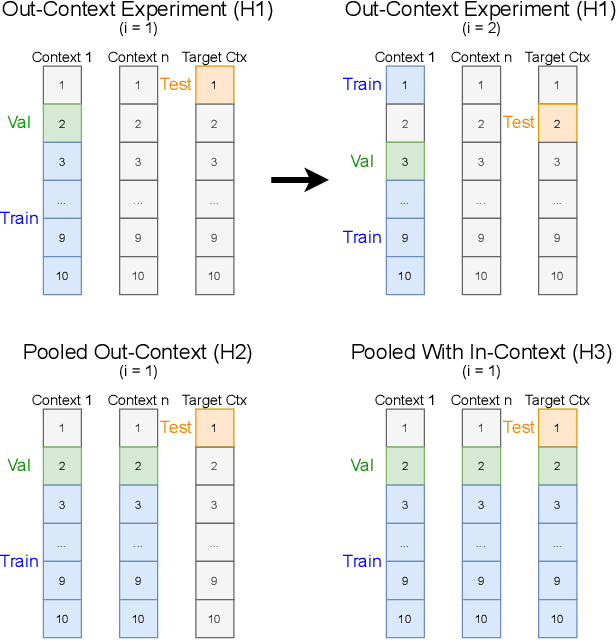
Abstract:In this paper, we examine the use of multi-lingual sentence embeddings to transfer predictive models for functional segmentation of adjudicatory decisions across jurisdictions, legal systems (common and civil law), languages, and domains (i.e. contexts). Mechanisms for utilizing linguistic resources outside of their original context have significant potential benefits in AI & Law because differences between legal systems, languages, or traditions often block wider adoption of research outcomes. We analyze the use of Language-Agnostic Sentence Representations in sequence labeling models using Gated Recurrent Units (GRUs) that are transferable across languages. To investigate transfer between different contexts we developed an annotation scheme for functional segmentation of adjudicatory decisions. We found that models generalize beyond the contexts on which they were trained (e.g., a model trained on administrative decisions from the US can be applied to criminal law decisions from Italy). Further, we found that training the models on multiple contexts increases robustness and improves overall performance when evaluating on previously unseen contexts. Finally, we found that pooling the training data from all the contexts enhances the models' in-context performance.
* 10 pages
Cross-Domain Generalization and Knowledge Transfer in Transformers Trained on Legal Data
Dec 15, 2021


Abstract:We analyze the ability of pre-trained language models to transfer knowledge among datasets annotated with different type systems and to generalize beyond the domain and dataset they were trained on. We create a meta task, over multiple datasets focused on the prediction of rhetorical roles. Prediction of the rhetorical role a sentence plays in a case decision is an important and often studied task in AI & Law. Typically, it requires the annotation of a large number of sentences to train a model, which can be time-consuming and expensive. Further, the application of the models is restrained to the same dataset it was trained on. We fine-tune language models and evaluate their performance across datasets, to investigate the models' ability to generalize across domains. Our results suggest that the approach could be helpful in overcoming the cold-start problem in active or interactvie learning, and shows the ability of the models to generalize across datasets and domains.
Computer-Assisted Creation of Boolean Search Rules for Text Classification in the Legal Domain
Dec 10, 2021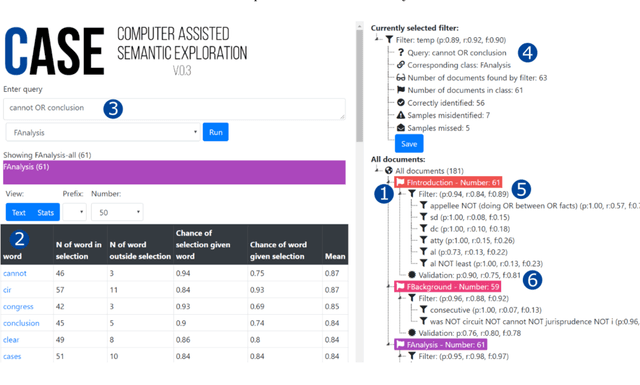
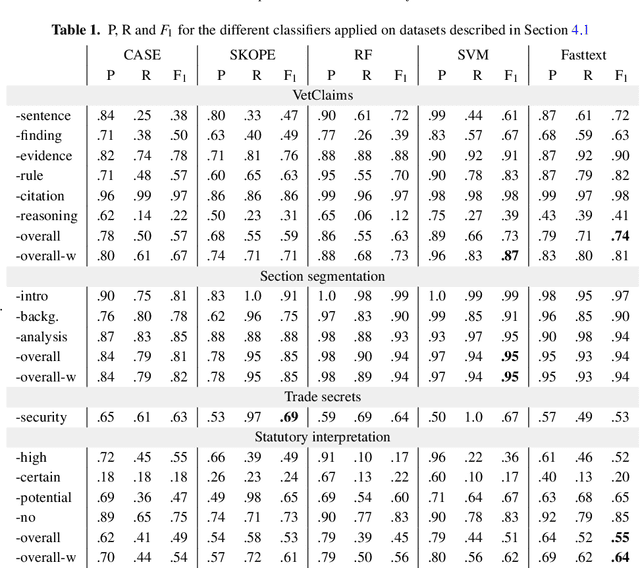
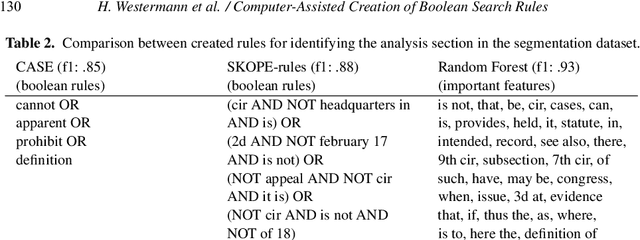
Abstract:In this paper, we present a method of building strong, explainable classifiers in the form of Boolean search rules. We developed an interactive environment called CASE (Computer Assisted Semantic Exploration) which exploits word co-occurrence to guide human annotators in selection of relevant search terms. The system seamlessly facilitates iterative evaluation and improvement of the classification rules. The process enables the human annotators to leverage the benefits of statistical information while incorporating their expert intuition into the creation of such rules. We evaluate classifiers created with our CASE system on 4 datasets, and compare the results to machine learning methods, including SKOPE rules, Random forest, Support Vector Machine, and fastText classifiers. The results drive the discussion on trade-offs between superior compactness, simplicity, and intuitiveness of the Boolean search rules versus the better performance of state-of-the-art machine learning models for text classification.
 Add to Chrome
Add to Chrome Add to Firefox
Add to Firefox Add to Edge
Add to Edge